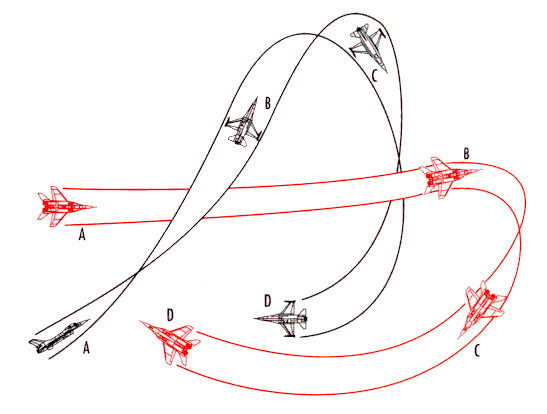If
the attacker is in the defender's plane of motion, the velocity
vector of the attacker determines the pursuit course. |
|
The velocity
vector, for the sake of our discussion, is the nose of the aircraft
and represents the direction that your jet travels through the
air at any given time. From the cockpit, the velocity vector is
depicted by the flight path marker.
What if the
attacker is not in the same plane of motion as the defender?
How do you determine the pursuit course for out-of-plane maneuvering?
When the attacker is not in the same plane as the defender,
pursuit course is deter-mined by the lift vector of the attacker.
An aircrafts lift vector is simply a vector that sticks directly
out of the top of the jet, perpendicular to the aircraft's wings.
At high G, an aircraft moves along its lift vector. You position
the lift vector by rolling, and when you pull G's, the nose
of the jet tracks toward the lift vector. The image below shows
a fighter's lift vector.
|
|
If an attacker
pulls out of plane with a bandit, his pursuit course is then determined
by where his lift vector is taking him. When the attacker pulls
out of plane with a bandit, he is, by definition, flying lag pursuit.
As he pulls back into a bandit, he may be flying lag, pure or
lead pursuit, depending on the geometry of the fight. (The image
below does not show a recommended maneuver but rather illustrates
the effect of out-of-plane maneuvering on the pursuit course.) |
 |
In this image,
the F-1 6 immediately goes to lag pursuit when he pulls his nose
out of plane in position B. At the top of this maneuver, he initiates
a pull back down into the defender at position C. In this position,
the F- 16 is in pure pursuit. Notice at position D, when the F-
16 enters the MiG-29's plane-of-motion, his nose is on the Fulcrum
and he is again flying a pure pursuit course.
Where you position
the nose of the aircraft is very important when a pilot attacks
the bandit. The use of attack pursuit geometry will be explained
later on in detail, and we will talk in specific terms about where
to place the jet in relationship to the bandit. For now, just
make sure you understand what each of the pursuit courses are
and what they do for you. |
| |
|
